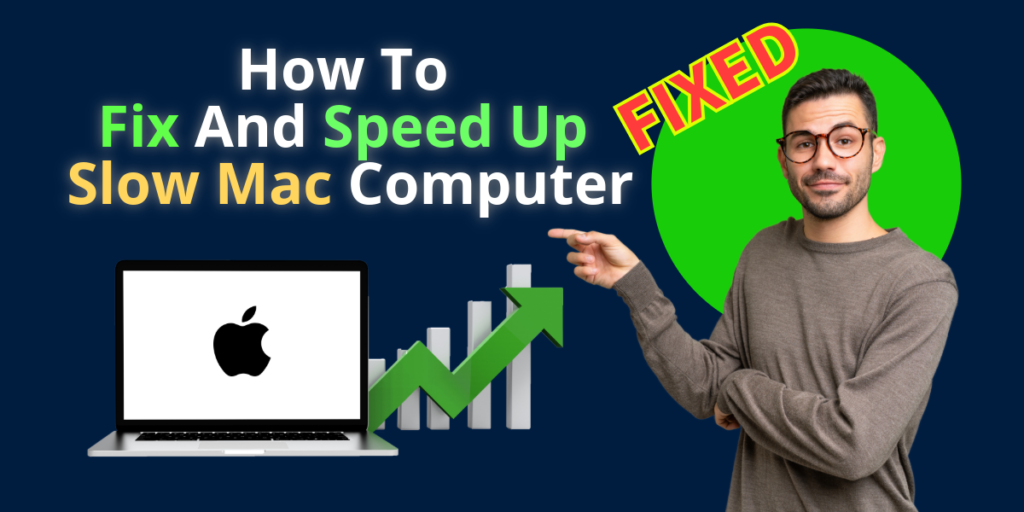How To Fix And Speed Up Your Slow Mac
If your Mac has been running slowly, there could be several underlying issues. In this guide, we’ll explore common causes and provide step-by-step solutions to speed up your Mac. By addressing background processes, full storage drives, and overheating, you can restore your Mac’s performance and efficiency.
Many Processes in the Background
One common reason for a slow Mac is too many processes running in the background. These can consume CPU and memory resources, causing your Mac to lag. Identifying and shutting down unnecessary processes can free up these resources and improve your Mac’s performance.
Fix: Shut Down Processes with Activity Monitor
Here’s how to manage background processes using Activity Monitor:
- Open Activity Monitor:
- Click on the Finder icon in the Dock.
- Go to Applications > Utilities > Activity Monitor.
- View Active Processes:
- In Activity Monitor, you’ll see a list of all the processes running on your Mac.
- You can sort these processes by CPU or Memory usage by clicking on the respective tabs.
- Identify Resource-Hogging Processes:
- Look for processes that are consuming a high percentage of CPU or memory.
- Pay special attention to any processes you don’t recognize or need.
- Shut Down Unnecessary Processes:
- Select the process you want to quit.
- Click the X button at the top left of the Activity Monitor window.
- Confirm by clicking Force Quit.
- Repeat as Necessary:
- Repeat this process for other unnecessary resource-hogging processes.
Full Storage Drive
A full storage drive can significantly slow down your Mac. When your Mac’s storage is almost full, it doesn’t have enough space to perform essential operations, leading to performance issues. Cleaning up your storage can help speed up your Mac.
Fix: Clean Up Your Storage Drive
Follow these steps to clean up your storage drive:
- Check Storage Usage:
- Click on the Apple menu in the top left corner.
- Select About This Mac > Storage.
- Review the breakdown of your storage usage.
- Remove Unnecessary Files:
- Go to Finder and navigate to folders with large files (e.g., Downloads, Documents, Movies).
- Delete files you no longer need.
- Empty the Trash:
- Right-click on the Trash icon in the Dock.
- Select Empty Trash.
- Optimize Storage:
- Click on the Apple menu > About This Mac > Storage.
- Click on Manage and follow the recommendations for optimizing storage, such as storing files in iCloud or reducing clutter.
- Uninstall Unused Applications:
- Go to Applications in Finder.
- Drag unused applications to the Trash and empty the Trash.
Overheating Mac
Overheating can cause your Mac to slow down as it tries to protect its components by throttling performance. Addressing overheating involves checking CPU usage, ensuring your MacOS is up to date, and managing web browser tabs and extensions.
Fix: CPU Usage Check, MacOS Update, and Web Browser Tabs & Extensions
Here’s how to address overheating and improve performance:
- Check CPU Usage:
- Open Activity Monitor from Applications > Utilities.
- Sort processes by CPU usage.
- Identify and quit processes that are consuming excessive CPU.
- Update MacOS:
- Click on the Apple menu > System Preferences > Software Update.
- If an update is available, click Update Now.
- Follow the on-screen instructions to complete the update.
- Manage Web Browser Tabs and Extensions:
- Close Unnecessary Tabs:
- Open your web browser and close any tabs you are not actively using.
- Remove Unnecessary Extensions:
- For Safari: Go to Safari > Preferences > Extensions. Disable or uninstall extensions you don’t need.
- For Chrome: Click on the three dots in the upper right corner > More Tools > Extensions. Disable or remove unused extensions.
- For Firefox: Click on the three dots in the upper right corner > Add-ons and themes > Extensions. Disable or remove unused extensions.
- Close Unnecessary Tabs:
Storage is not optimized properly
Improperly optimized storage can lead to sluggish performance on your Mac. Even if you have ample space, disorganized and fragmented files can slow down access times and overall system speed. Properly managing and organizing your files and data ensures your Mac runs more efficiently.
Fix: Manage Files and Data
Follow these steps to optimize your storage:
- Organize Your Files:
- Create folders for different categories (e.g., Work, Personal, Media) to keep your files organized.
- Move files into their respective folders.
- Use Built-in Tools:
- Go to Apple menu > About This Mac > Storage > Manage.
- Follow the recommendations provided for optimizing storage, such as:
- Storing files in iCloud.
- Automatically removing watched TV shows and movies.
- Emptying the Trash automatically.
- Remove Duplicates:
- Use third-party apps like Gemini 2 to find and remove duplicate files.
- Archive Old Files:
- Transfer old files to an external drive or cloud storage to free up space on your Mac.
Not Enough RAM
Insufficient RAM can cause your Mac to struggle with multitasking and running memory-intensive applications. Flushing your RAM can help free up memory and improve performance.
Fix: Use Terminal to Flush RAM
- Open Terminal:
- Go to Applications > Utilities > Terminal.
- Flush RAM:
- Type the following command and press Enter:
sudo purgeToo Many Unused Apps
Having too many unused apps can take up valuable storage space and resources, slowing down your Mac. Uninstalling these apps can help free up space and improve performance.
Fix: Uninstall Unused Apps
Here’s how to uninstall unused apps:
- Open Finder:
- Click on the Finder icon in the Dock.
- Go to Applications:
- Navigate to the Applications folder.
- Select Unused Apps:
- Identify and select the apps you no longer use.
- Move to Trash:
- Drag the unused apps to the Trash.
- Alternatively, right-click the app and select Move to Trash.
- Empty the Trash:
- Right-click on the Trash icon in the Dock.
- Select Empty Trash.
Login Items
Login items are applications that start automatically when you log into your Mac. Having too many login items can slow down the startup process and overall performance. Removing unnecessary login items can help speed up your Mac.
Fix: Remove Login Items
Here’s how to remove login items:
- Open System Preferences:
- Click on the Apple menu > System Preferences.
- Go to Users & Groups:
- Select Users & Groups.
- Select Your User Account:
- Click on your user account on the left side of the window.
- Open Login Items:
- Click on the Login Items tab.
- Remove Unnecessary Items:
- Select the items you want to remove.
- Click the – button below the list to remove them.
Overloaded Visuals
MacOS animations and visual effects can be pleasing to the eye but may consume valuable system resources. Adjusting these settings can help improve performance, especially on older Macs.
Fix: Adjust Animations
Here’s how to adjust animations and reduce visual effects:
- Open System Preferences:
- Click on the Apple menu > System Preferences.
- Go to Accessibility:
- Select Accessibility.
- Reduce Motion:
- Click on Display in the sidebar.
- Check the box next to Reduce motion.
- Reduce Transparency:
- Also in the Display section, check the box next to Reduce transparency.
Conclusion
By following these steps, you can address common issues that cause your Mac to run slowly. Regular maintenance, such as managing background processes, cleaning up your storage, and preventing overheating, will help keep your Mac running smoothly and efficiently.








